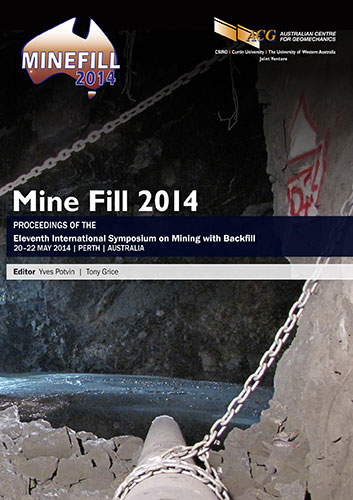Design and implementation of cemented rockfill at the Ballarat Gold Project

|
Authors: Sainsbury, DP; Sainsbury, BL |
DOI https://doi.org/10.36487/ACG_rep/1404_15_Sainsbury
Cite As:
Sainsbury, DP & Sainsbury, BL 2014, 'Design and implementation of cemented rockfill at the Ballarat Gold Project', in Y Potvin & T Grice (eds), Mine Fill 2014: Proceedings of the Eleventh International Symposium on Mining with Backfill, Australian Centre for Geomechanics, Perth, pp. 205-216, https://doi.org/10.36487/ACG_rep/1404_15_Sainsbury
Abstract:
Cemented rockfill (CRF) has been implemented at the Ballarat Gold Project to allow pillarless recovery of the narrow vein gold deposit. The stoping extraction strategy requires both vertical and horizontal CRF exposures to remain stable and prevent excessive dilution. This paper outlines a program of initial laboratory testing and numerical modelling to ensure safe and efficient CRF exposure design. A novel numerical modelling approach has been developed to accurately simulate the particulate nature of CRF material. The stability of CRF exposures have been determined by conducting a series of three-dimensional numerical models that incorporate extraction, filling and the exposure sequence of the CRF filled stopes.
References:
Belem, T & Benzaazoua, M 2008, ‘Design and Application of Underground Mine paste Backfill Technology’, Journal of Geotechnical and Geological Engineering, vol. 26, no. 2, pp. 147-74.
Caceres, C 2005, ‘Effect of Backfill on Longhole Open Stoping’, MASc Thesis, University of British Columbia.
Connors, CC 2001, ‘Methods to Reduce Portland Cement Consumption in Backfill at Jerritt Canyon’s Underground Mines’, in D Stone (ed.), Proceedings of the 7th International Symposium on Mining with Backfill, Society for Mining, Metallurgy, and Exploration, Littleton, pp. 301-10.
Itasca Consulting Group, Inc. 2013, 3DEC Three-Dimensional Distinct Element Code, Version 5.0, Itasca Consulting Group, Inc., Minneapolis, .
Mitchell, RJ, Olsen, RS & Smith, JD 1982, ‘Model studies on cemented tailings used in mine backfill’, Canadian Geotechnical Journal, vol. 19, pp. 14-28.
Mitchell, RJ & Roettger, JJ 1989, ‘Analysis and modelling of sill pillars’, Innovations in mining backfill technology, Balkema, Rotterdam, pp. 53-62.
Stone, DMR 1993, ‘The Optimization of Mix Designs for Cemented Rockfill’, in HW Glen (ed.), Proceedings of the Fifth International Symposium on Mining with Backfill, South African Institute of Mining and Metallurgy, Johannesburg, pp. 249-53.
Stone, DMR 2007, ‘Factors that affect cemented rockfill quality in Nevada Mines’, CIM Bulletin, vol. 100, no. 1103, pp. 1-6.
Swan, G & Brummer, RK 2001, ‘Backfill Design for Deep, Underhand Drift-and-Fill Mining’, in D Stone (ed.), Proceedings of the Seventh International Symposium of Mining with Backfill, Society for Mining, Metallurgy, and Exploration, Englewood, pp. 359-68.
Taghavi, R & Pierce, M 2011, ‘Modeling flow of fragmented rock with 3DEC: A polyhedral DEM approach’, in D Sainsbury, R Hart, C Detournay and M Nelson (eds), Proceedings of the 2nd International FLAC/DEM Symposium, Itasca International Inc., Minneapolis, pp. 37-48.
© Copyright 2024, Australian Centre for Geomechanics (ACG), The University of Western Australia. All rights reserved.
View copyright/legal information
Please direct any queries or error reports to repository-acg@uwa.edu.au
View copyright/legal information
Please direct any queries or error reports to repository-acg@uwa.edu.au